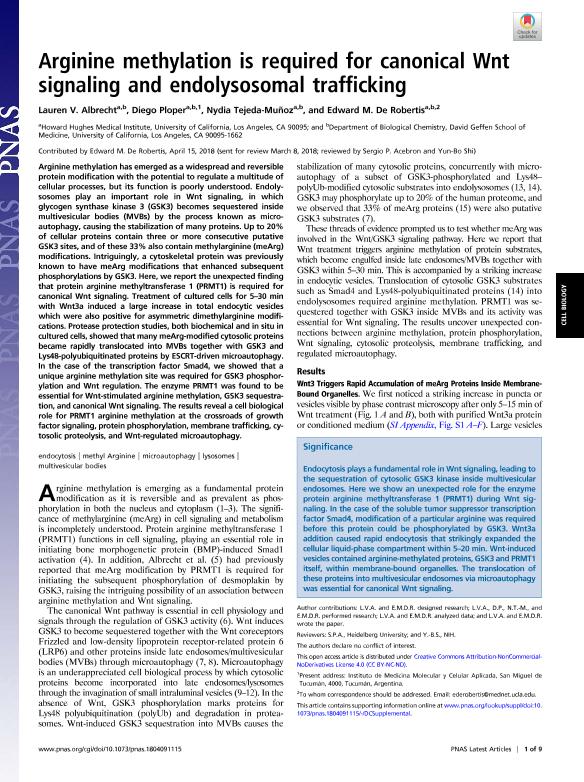Mostrar el registro sencillo del ítem
dc.contributor.author
Albrecht, Lauren V.
dc.contributor.author
Ploper, Diego

dc.contributor.author
Tejeda Muñoz, Nydia
dc.contributor.author
De Robertis, Edward M.
dc.date.available
2020-04-03T18:23:58Z
dc.date.issued
2018-05
dc.identifier.citation
Albrecht, Lauren V.; Ploper, Diego; Tejeda Muñoz, Nydia; De Robertis, Edward M.; Arginine methylation is required for canonical Wnt signaling and endolysosomal trafficking; National Academy of Sciences; Proceedings of the National Academy of Sciences of The United States of America; 115; 23; 5-2018; E5317-E5325
dc.identifier.issn
0027-8424
dc.identifier.uri
http://hdl.handle.net/11336/101923
dc.description.abstract
Arginine methylation has emerged as a widespread and reversible protein modification with the potential to regulate a multitude of cellular processes, but its function is poorly understood. Endolysosomes play an important role in Wnt signaling, in which glycogen synthase kinase 3 (GSK3) becomes sequestered inside multivesicular bodies (MVBs) by the process known as microautophagy, causing the stabilization of many proteins. Up to 20% of cellular proteins contain three or more consecutive putative GSK3 sites, and of these 33% also contain methylarginine (meArg) modifications. Intriguingly, a cytoskeletal protein was previously known to have meArg modifications that enhanced subsequent phosphorylations by GSK3. Here, we report the unexpected finding that protein arginine methyltransferase 1 (PRMT1) is required for canonical Wnt signaling. Treatment of cultured cells for 5-30 min with Wnt3a induced a large increase in total endocytic vesicles which were also positive for asymmetric dimethylarginine modifications. Protease protection studies, both biochemical and in situ in cultured cells, showed that many meArg-modified cytosolic proteins became rapidly translocated into MVBs together with GSK3 and Lys48-polyubiquitinated proteins by ESCRT-driven microautophagy. In the case of the transcription factor Smad4, we showed that a unique arginine methylation site was required for GSK3 phosphorylation and Wnt regulation. The enzyme PRMT1 was found to be essential for Wnt-stimulated arginine methylation, GSK3 sequestration, and canonical Wnt signaling. The results reveal a cell biological role for PRMT1 arginine methylation at the crossroads of growth factor signaling, protein phosphorylation, membrane trafficking, cytosolic proteolysis, and Wnt-regulated microautophagy.
dc.format
application/pdf
dc.language.iso
eng
dc.publisher
National Academy of Sciences

dc.rights
info:eu-repo/semantics/openAccess
dc.rights.uri
https://creativecommons.org/licenses/by-nc-sa/2.5/ar/
dc.subject
ENDOCYTOSIS
dc.subject
LYSOSOMES
dc.subject
METHYL ARGININE
dc.subject
MICROAUTOPHAGY
dc.subject
MULTIVESICULAR BODIES
dc.subject.classification
Bioquímica y Biología Molecular

dc.subject.classification
Ciencias Biológicas

dc.subject.classification
CIENCIAS NATURALES Y EXACTAS

dc.title
Arginine methylation is required for canonical Wnt signaling and endolysosomal trafficking
dc.type
info:eu-repo/semantics/article
dc.type
info:ar-repo/semantics/artículo
dc.type
info:eu-repo/semantics/publishedVersion
dc.date.updated
2019-10-16T19:29:37Z
dc.identifier.eissn
1091-6490
dc.journal.volume
115
dc.journal.number
23
dc.journal.pagination
E5317-E5325
dc.journal.pais
Estados Unidos

dc.journal.ciudad
Washington
dc.description.fil
Fil: Albrecht, Lauren V.. University of California at Los Angeles; Estados Unidos
dc.description.fil
Fil: Ploper, Diego. University of California at Los Angeles; Estados Unidos. Consejo Nacional de Investigaciones Científicas y Técnicas. Centro Científico Tecnológico Conicet - Tucumán. Instituto Superior de Investigaciones Biológicas. Universidad Nacional de Tucumán. Instituto Superior de Investigaciones Biológicas; Argentina
dc.description.fil
Fil: Tejeda Muñoz, Nydia. University of California at Los Angeles; Estados Unidos
dc.description.fil
Fil: De Robertis, Edward M.. University of California at Los Angeles; Estados Unidos
dc.journal.title
Proceedings of the National Academy of Sciences of The United States of America

dc.relation.alternativeid
info:eu-repo/semantics/altIdentifier/url/http://www.pnas.org/lookup/doi/10.1073/pnas.1804091115
dc.relation.alternativeid
info:eu-repo/semantics/altIdentifier/doi/http://dx.doi.org/10.1073/pnas.1804091115
Archivos asociados
